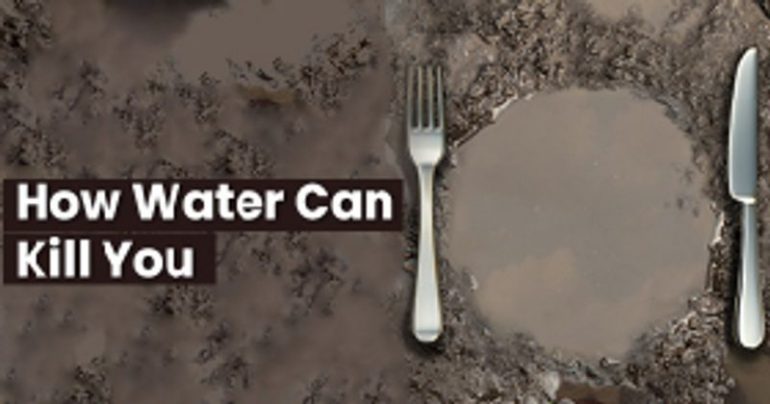Intimidating title, right? However, it is not an exaggeration.
The reason why it strikes so is that most of us are oblivious of this possibility throughout our lives, which demands us to adopt a certain lifestyle to ensure life at all. For instance, water is the fundamental element of existence as a whole, be it planet earth or us humans. Now, like other types of pollution, water pollution is also a pertinent phenomenon. Although it has hazardous effects on both the planet and humans, the negligence on our part is inescapable.
You must be thinking; it is not possible for you to find time to fight the water pollution. You are wrong!!! You can start the battel at a personal level by regulating the water usage in your house.
For instance, you can switch to boiled water or get a filtration device installed at your home. These will work fine for helping you prevent the water-related diseases that go inside you through food or water intake.
However, there are infections that we stay oblivious of. These include the ones caused by the use of unclean water during bathing, washing clothes, and dishes. How do avoid these? Keep your water tank cleaning by booking professional services every six months to prevent waterborne infections or starters.
Do you think it is not crucial?
Keep reading to know about the 11 common infections caused by contaminated water. It will help you see the importance of drinking filtered/boiled water and cleaning your water tank.
1. Cholera

Disease
Cholera also called “dirty hands disease” is caused by Vibrio cholera’s bacterium. It is transmitted via the food or water that has been interacted with and contaminated by infected people’s stools.
Location
Africa, Latin America, Asia, Europe, Oceania
Number of Cases
Millions of cases were identified.
148,000 deaths each year.
Treatment
Cholera treatment involves replacing lost fluids and electrolytes. Using oral rehydration salts is the quickest and most effective way. Prevention also helps fight the disease (water supply, healthy drinks in sufficient quantity, good hygiene, personal and food hygienic evacuation of excreta).
2. Dengue Fever
Disease
Dengue fever is a severe influenza-like infectious disease, transmitted by infected female tiger mosquitoes (genus Aedes), with a rarely fatal outcome. Dengue fever affects infants, children, and adults.
Location
Africa, Americas, Eastern Mediterranean, South Asia, Western Pacific
Number of Cases
Three hundred ninety million cases of dengue per year.
Of which 96 million have clinical manifestations.
Treatment
To this day, no vaccines are claimed to protect against dengue fever successfully. The most effective prevention method remains personal protection which must prevent mosquito bites: mosquito nets, long-sleeved clothing, and repellent products.
3. Diarrhea
Disease
Diarrhea is an infection’s symptom caused by many bacterial, parasitic, and viral organisms, most of which can be spread through contaminated water. It is more common when there is no clean water for drinking, cooking, and cleaning and basic hygiene rules are not followed.
Location
Whole world.
Number of Cases
1.7 billion people are affected by diarrhea each year.
More than 842,000 people, including 350,000 children under the age of 5, die.
Treatment
To fight against this scourge, you need to ensure the use of clean water for drinking, bathing, and washing purposes. How to make this sure? Don’t worry, we have got you covered. Book water tank cleaning services regularly (every six months) to prevent the breading of diarrhea-causing bacteria.
Also, you should ensure improved sanitation, appropriate personal and food hygiene, and health education on how the infection is spread.
4. Scabies
Disease
It is a contagious skin infection caused by a microscopic mite (Sarcoptes scabiei), scabies spread quickly in crowded conditions. It is most commonly signaled by a papular rash between the fingers of the hand.
Location
Whole world.
Number of Cases
Nearly 300 million cases are recorded each year.
Treatment
Personal hygiene is an important preventive measure, and access to a clean water supply is essential for controlling this disease. Patients are treated with acaricidal ointment preceded by a warm bath with careful soaping. Infested clothing should be sterilized or washed in hot soapy water.
5. Hepatitis
Disease
Two viruses become the cause of hepatitis (hepatitis E and A) and can be transmitted through water and food. Infectious causes include insufficient water supply, poor sanitation, and poor hygiene quality.
Location
The strong presence of hepatitis A is worldwide: Africa / South America /Central America / Asia.
Number of Cases
Hepatitis E: recorded cases per year are 20 million & with 44,000 deaths in 2015.
Treatment
There is no anti-viral medication. Prevention involves education on quality sanitation and personal hygiene care, including washing hands, water supplies, sufficient cleanliness, and proper waste disposal.
6. Malnutrition
Disease
Undernutrition affects one in three people of all ages; however, it especially concerns the poorest and those who have insufficient access to good quality sanitation, clean water, and a lack of health education.
Location
20% of the developing countries and worldwide.
Number of Cases
Seven hundred ninety-five million people are undernourished.
Treatment
Interventions that contribute to the prevention of malnutrition include: improving the water supply, sanitation, and hygiene, education in good hygiene practices, better access to food in sufficient quantity and quality, as well as essential health services.
7. Onchocerciasis
Disease
It is the second major cause of blindness caused by infectious, onchocerciasis or “river blindness,” is a parasitic disease whose vector is the black fly. This tiny black gnat breeds in water.
Location
Africa / South America / Central America / Arabian Peninsula
Number of Cases
18 million people are infected worldwide.
Treatment
Two main measures exist to fight against onchocerciasis: the spraying of insecticides on the breeding sites of blackflies and the treatment of patients with a drug (ivermectin) that kills the young worms.
8. Malaria
Disease
Malaria, or malaria in English, is the most important parasitic infectious disease globally. It is caused by a parasite of the genus Plasmodium, transmitted at night when bitten by a female mosquito of the genus Anopheles. Malaria can progress to a severe and fatal cerebral form without prompt and effective treatment.
Location
Sub-Saharan Africa, Southeast Asia, South America
Number of Cases
Between 300 and 500 million cases.
More than one million deaths each year.
Treatment
No vaccine is available to fight malaria. Preventive antimalarial drugs do not guarantee absolute protection against infection. It is important to protect yourself from mosquito bites: mosquito nets, mosquito repellents, prevention of malaria during pregnancy, early detection, and control of malaria epidemics.
To inhibit the propagation of malaria mosquitos, take measures to ensure there is no stranded water in your home. One way to ensure this is to get your water tank cleaned by professionals.
So, when was the last time you booked cleaning services for your water tank? Long time?
It is never too late. You can do it now.
Don’t know where to book? It is easy!
Just write water tank cleaning near me in your search engine to find your area’s best professional online.

9. Schistosomiasis
Disease
Schistosomiasis or bilharziasis is a waterborne disease considered the second most important parasitic infection after malaria. Transmission occurs when people with schistosomiasis contaminate freshwater sources with their feces.
Location
Africa / Central America / Caribbean / Brazil / East Asia / Iran / Saudi Arabia
Number of Cases
200 million people were infected.
Potentially 600 million people can contract the infection and are at the risk of catching it.
Treatment
Improving the sanitation and drinking water supply minimizes contamination of fresh water and reduces contact with it, limiting the risk of transmission. Health education is a fundamental component that guarantees community participation in control interventions.
10. Trachoma
Disease
The cause of this disease is an organism called Chlamydia trachomatis, this infectious eye disease cand n cause blindness after repeated infections. It is transmitted by the hands, clothing, or flies that land on the face of the infected child.
Location
Middle East / North and Sub-Saharan Africa / Indian Subcontinent / South Asia / China / Latin America / Australia / Pacific Islands.
Number of Cases
Six million people in the world are blind due to trachoma.
More than 150 million people need treatment.
Treatment
Evidently, good personal hygiene and good environmental hygiene (improved access to water, improved sanitation, reduced fly larval sites, and increased facial hygiene with clean water) effectively control trachoma.
11. Typhoid
Disease
Paratyphoid and Typhoid fevers are infections caused by Salmonella paratyphoid and Salmonella typhi bacteria. Anyone can get infected by ingesting drinks or food that has been handled by an infected person or by consuming drinking water contaminated with stool or urine containing the bacteria.
Location
Most are less industrialized countries.
Number of Cases
17 million cases globally.
Treatment
Personal hygiene, hand washing, healthy water supply, and adequate sanitation. A vaccine is available, although it is not routinely recommended and does not provide complete protection against infection.







